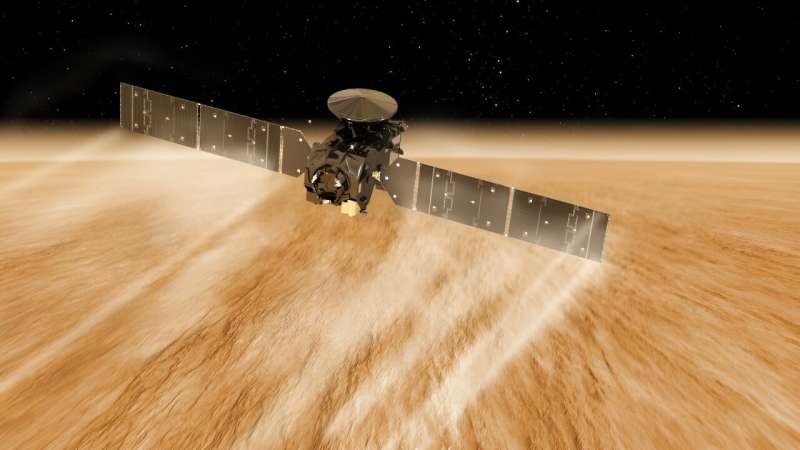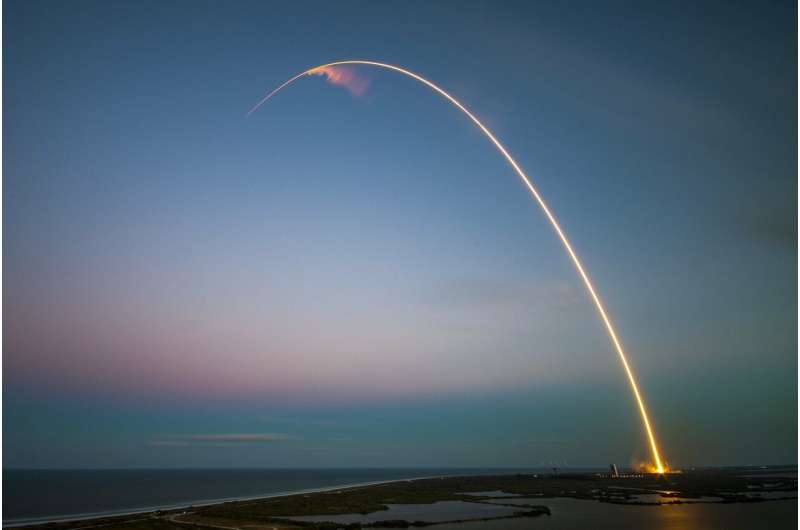
Copernical Team
Aerocapture is a 'free lunch' in space exploration

When spacecraft return to Earth, they don't need to shed all their velocity by firing retro-rockets. Instead, they use the atmosphere as a brake to slow down for a soft landing. Every planet in the solar system except Mercury has enough of an atmosphere to allow aerobraking maneuvers, and could allow high-speed exploration missions. A new paper looks at the different worlds and how a spacecraft must fly to take advantage of this "free lunch" to slow down at the destination.
Aerocapture is an orbital transfer maneuver in which a spacecraft makes a single pass through a planetary atmosphere to decelerate and achieve orbit insertion. On the other hand, aerobraking uses a propulsive burn plus repeated dips into the atmosphere—i.e., atmospheric drag—to gradually slow the spacecraft and reduce the size of the orbit to achieve orbit insertion.
The new paper posted to the arXiv preprint server, by Athul Pradeepkumar Girija from the School of Aeronautics and Astronautics at Purdue University, notes that one of the significant risks associated with aerocapture is the uncertainty in the atmospheric density.
If warp drives are impossible, maybe faster-than-light communication is still on the table?

I'm sure many readers of Universe Today are, like me, fans of the science fiction genre. From the light sabers of "Star Wars" to the neuralyzer of "Men in Black," science fiction has crazy inventions aplenty and once science fiction writers dream it, scientists and engineers try and create it. Perhaps the holy grail of science fiction creations is the warp drive from "Star Trek" and it is fair to say that many have tried to work out if it is even possible to travel faster than the speed of light. To date, alas, to no avail but if the warp drive eludes us, what about faster-than-light communication.
Let's start with the warp drive. The concept is a drive that can propel a spacecraft at speeds in excess of the speed of light. According to the "Star Trek" writers, the speed was described in factors of warp speed where they are converted to multiples of the speed of light by multiplication with the cubic function of the warp factor itself. Got it. Don't worry, it's not crucial to this article.
SpaceX sends up Space Coast's 66th launch of the year

SpaceX chalked up another Starlink mission from Cape Canaveral Space Force Station to mark the Space Coast's 66th launch of the year.
A Falcon 9 with 23 of the company's Starlink internet satellites lifted off from Canaveral's Space Launch Complex 40 at 11:20 p.m. Monday.
The booster flew for the 17th time, the third time SpaceX has flown one of its boosters 17 times, although one has flown 18 missions. It landed safely on the droneship Just Read the Instructions downrange in the Atlantic.
This is the fourth month in a row the Space Coast has shoehorned in seven launches in a month, and the fifth time this year, although only the second time SpaceX has been responsible for all seven of those launches in one month.
SpaceX has flown 62 of the 66 Space Coast missions overall, with Relativity Space making its lone launch of its Terran 1 3D-printed rocket back in March, and United Launch Alliance managing one Delta IV Heavy and two Atlas V rocket launches since June.
SpaceX has also flown 25 times from California's Vandenberg Space Force Station, making this its 87th orbital flight this year, not counting the two failed attempts to launch its Starship and Super Heavy rocket from Texas.
Warming ocean causing rapid glacier retreat

With all eyes about to focus on the COP28 climate conference in Dubai, new scientific findings show, again, that the climate crisis is taking its toll on Antarctica – a continent, up to recently, thought better able to withstand the immediate effects of rising global temperatures.
Using satellite data, scientists have discovered that the ice shelf extending into the ocean from Cadman Glacier on the west Antarctic Peninsula collapsed, leaving the glacier exposed to unusually warm ocean water, which caused the glacier to accelerate and retreat rapidly.
Wits researchers pioneer a new way of searching for dark matter
 The existence of Dark Matter is a long-standing puzzle in our universe. Dark Matter makes up about a quarter of our universe, yet it does not interact significantly with ordinary matter. The existence of Dark Matter has been confirmed by a series of astrophysical and cosmological observations, including in the stunning recent pictures from James Webb Space Telescope.
However, up to date, n
The existence of Dark Matter is a long-standing puzzle in our universe. Dark Matter makes up about a quarter of our universe, yet it does not interact significantly with ordinary matter. The existence of Dark Matter has been confirmed by a series of astrophysical and cosmological observations, including in the stunning recent pictures from James Webb Space Telescope.
However, up to date, n Understanding charged particles helps physicists simulate element creation in stars
 New research from North Carolina State University and Michigan State University opens a new avenue for modeling low-energy nuclear reactions, which are key to the formation of elements within stars. The research lays the groundwork for calculating how nucleons interact when the particles are electrically charged.
Predicting the ways that atomic nuclei - clusters of protons and neutrons, to
New research from North Carolina State University and Michigan State University opens a new avenue for modeling low-energy nuclear reactions, which are key to the formation of elements within stars. The research lays the groundwork for calculating how nucleons interact when the particles are electrically charged.
Predicting the ways that atomic nuclei - clusters of protons and neutrons, to NASA Scientific Balloons Ready for Flights Over Antarctica
 NASA kicks off its annual Antarctic Long Duration Balloon Campaign around Dec. 1, which includes three scientific balloon flights planned for launch from the long-duration balloon (LDB) Camp near McMurdo Station, Antarctica. NASA's stadium-sized, zero-pressure balloons will support a total of five missions on the long-duration flights with one mission vying to break NASA's heavy-lift, long-durat
NASA kicks off its annual Antarctic Long Duration Balloon Campaign around Dec. 1, which includes three scientific balloon flights planned for launch from the long-duration balloon (LDB) Camp near McMurdo Station, Antarctica. NASA's stadium-sized, zero-pressure balloons will support a total of five missions on the long-duration flights with one mission vying to break NASA's heavy-lift, long-durat Earth's magnetic field protects life on Earth from radiation
 The Earth's magnetic field plays a big role in protecting people from hazardous radiation and geomagnetic activity that could affect satellite communication and the operation of power grids. And it moves. Scientists have studied and tracked the motion of the magnetic poles for centuries. The historical movement of these poles indicates a change in the global geometry of the Earth's magnetic fiel
The Earth's magnetic field plays a big role in protecting people from hazardous radiation and geomagnetic activity that could affect satellite communication and the operation of power grids. And it moves. Scientists have studied and tracked the motion of the magnetic poles for centuries. The historical movement of these poles indicates a change in the global geometry of the Earth's magnetic fiel Cassini's Grand Finale Unveils Variations in Saturn's D Ring influx
 In a significant addition to our understanding of Saturn's atmospheric dynamics, Joshua Dreyer is poised to present his doctoral thesis at the Swedish Institute of Space Physics (IRF) and Uppsala University. His research, which scrutinizes the effects of material from Saturn's innermost D ring falling into its upper atmosphere, marks a novel chapter in space exploration and planetary science.
In a significant addition to our understanding of Saturn's atmospheric dynamics, Joshua Dreyer is poised to present his doctoral thesis at the Swedish Institute of Space Physics (IRF) and Uppsala University. His research, which scrutinizes the effects of material from Saturn's innermost D ring falling into its upper atmosphere, marks a novel chapter in space exploration and planetary science. Quantum Space launches Sentry to pioneer deep space communications network
 Quantum Space, a trailblazer in deep space infrastructure, has announced the imminent launch of its ambitious Sentry mission, marking a significant leap in developing a modern connectivity network for deep space. The company's pioneering project, QuantumNet, aims to revolutionize space communication by offering high-speed, uninterrupted connectivity in the vast expanse of deep space, stretching
Quantum Space, a trailblazer in deep space infrastructure, has announced the imminent launch of its ambitious Sentry mission, marking a significant leap in developing a modern connectivity network for deep space. The company's pioneering project, QuantumNet, aims to revolutionize space communication by offering high-speed, uninterrupted connectivity in the vast expanse of deep space, stretching 